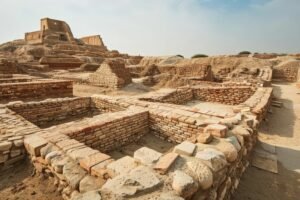Often hailed as the “Cradle of Civilization,” Ancient Mesopotamia stands as a testament to humanity’s earliest strides towards organized society. Nestled between the Tigris and Euphrates rivers, this ancient region, which encompasses parts of modern-day Iraq, Syria, and Turkey, was a melting pot of innovation, culture, and governance. In this article, we will delve into the remarkable achievements of Mesopotamian society, exploring their contributions to writing, law, architecture, and more.
1. The Geography and Significance of Mesopotamia
Mesopotamia, meaning “between the rivers” in Greek, was a fertile land that played a crucial role in early human history. The rivers provided irrigation for agriculture, which led to surplus food production and supported a growing population. This surplus allowed for the development of complex societies, leading to the rise of some of the world’s first cities, such as Uruk, Ur, and Babylon.
2. The Birth of Writing: Cuneiform Script
One of Mesopotamia’s most profound contributions was the invention of writing. Around 3400 BCE, the Sumerians, one of Mesopotamia’s earliest cultures, developed cuneiform script. Initially used for record-keeping and administrative purposes, cuneiform evolved into a versatile system that recorded literature, laws, and scientific observations. The Epic of Gilgamesh, one of the oldest known literary works, was written in cuneiform and offers valuable insights into Mesopotamian culture and beliefs.
3. Innovations in Law: The Code of Hammurabi
Another monumental achievement from Mesopotamia is the Code of Hammurabi, one of the earliest and most comprehensive written legal codes. Established by King Hammurabi of Babylon around 1754 BCE, this code consisted of 282 laws covering various aspects of daily life, from family matters to trade and criminal justice. The Code of Hammurabi is renowned for its principle of lex talionis, or “an eye for an eye,” and reflects the advanced level of legal and social organization in Mesopotamian society.
4. Mesopotamian Architecture and Urban Planning
Mesopotamian architecture was characterized by its grandeur and complexity. The ziggurat, a massive terraced structure, was a prominent feature of Mesopotamian cities. These stepped pyramids were dedicated to the gods and served as religious and administrative centers. The most famous ziggurat is the Ziggurat of Ur, which stood as a monumental testament to Mesopotamian architectural prowess.
Cities in Mesopotamia were meticulously planned, with residential areas, marketplaces, and temples organized in a grid pattern. The development of these urban centers was instrumental in facilitating trade and communication across the region.
5. Contributions to Science and Mathematics
Mesopotamians made significant advancements in science and mathematics, laying the groundwork for future developments. Their mathematicians developed a base-60 number system, which influenced the way we measure time and angles today. Mesopotamian astronomers also made early observations of celestial bodies, contributing to the development of the lunar calendar and influencing later astronomical studies.
6. The Religion and Mythology of Mesopotamia
Religion played a central role in Mesopotamian life, with a pantheon of gods and goddesses governing various aspects of the natural and supernatural world. Major deities included Anu (the sky god), Enlil (the god of wind and storms), and Ishtar (the goddess of love and war). Mesopotamian mythology is rich with stories of creation, divine intervention, and epic heroism, as seen in texts like the Epic of Gilgamesh and the Enuma Elish.
7. The Legacy of Mesopotamian Civilization
The legacy of Mesopotamian civilization extends far beyond its temporal and geographical boundaries. The innovations and ideas originating in Mesopotamia laid the foundation for subsequent cultures and civilizations. From the development of writing and law to advancements in architecture and science, Mesopotamian contributions have had a lasting impact on human history.
Conclusion
Ancient Mesopotamia, with its vibrant culture and groundbreaking achievements, truly earned its place as the “Cradle of Civilization.” By examining its contributions to writing, law, architecture, and science, we gain a deeper appreciation for the remarkable advancements made by this early society. As we continue to explore and understand the complexities of Mesopotamian civilization, we not only uncover the past but also enrich our understanding of the foundations of modern society.









